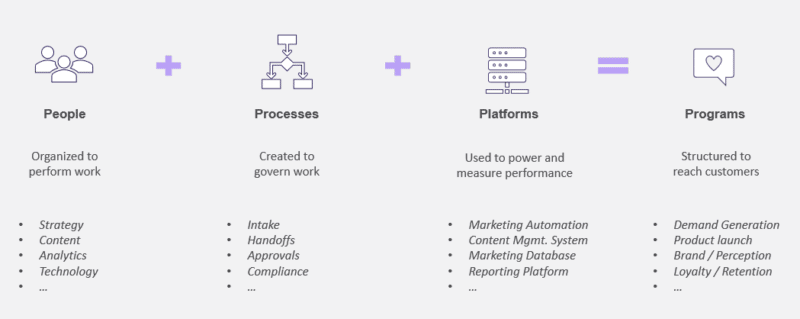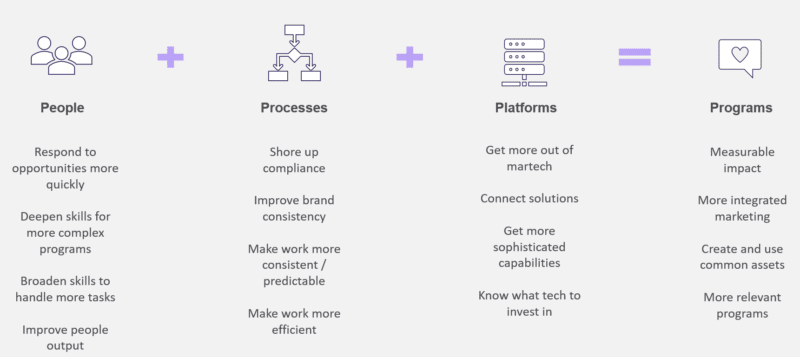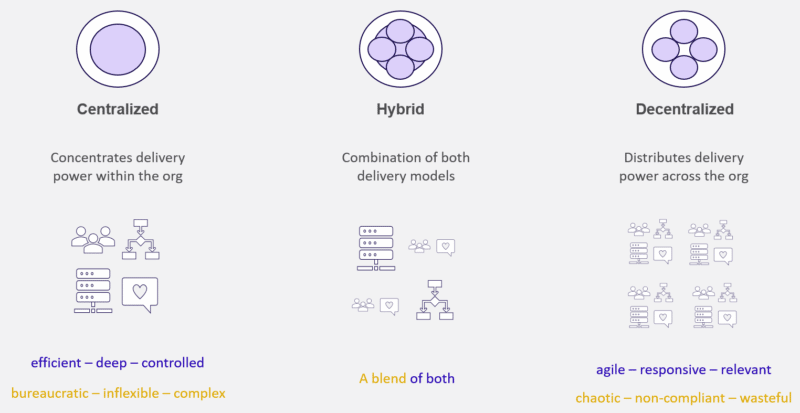The first part of a two-part article looks at reasons to move from a decentralized, rapid response marketing model to a more centralized model as a business matures.
Marketing organizations in fast growth companies are like that voice -cracking, pimple-speckled teenaged who’s just hit their growth spurt. Your all-hands-on-deck/jack-of-all-trades marketing delivery approach which propelled early growth is now struggling to scale, resulting in too-tight shoes and highwater pants which cannot be coaxed to magically expand and stretch.
While a more decentralized approach enabled rapid response and amazing agility during hyper-growth, as your company matures you need efficiency, program sophistication, and tighter compliance that comes from specialization. Done right, centralization can help your marketing org bridge from the awkward teens into adulthood while maintaining some of the magic that made you high growth in the first place. But buying longer pants and larger shoes every 6 months only allows revenue to grow at the same rate as cost — as a savvy leader you seek to grow revenue faster than cost.
That means selecting a marketing model that scales profitability over time. While more centralization is likely, there are tradeoffs which need careful consideration to find the right balance, optimize delivery, and future-proof your marketing organization.
The elements of a marketing model
Marketing models are comprised of the people, processes, and platforms which bring your programs to life. Different from marketing strategy, a model focuses on the operational aspects of marketing and how they harmonize to enable that strategy.

People perform the work. These are strategists, content builders, copywriters, analytics and martech specialists (to name a few).
Processes govern work and ensure consistent outcomes via intake mechanisms, handoffs between teams, approval, and compliance rules.
Platforms are the technologies used to power and measure performance. These are (but not limited to) marketing automation platforms, content management systems, event tools, marketing databases, and reporting platforms.
Programs are the marketing content and campaigns which bring strategy to life: demand generation, loyalty and retention, or product launches.
Common marketing model challenges
Within each marketing model element, there are common operational challenges that can hamstring marketing strategy; for a high-growth company, the challenges hit faster and harder leaving you gasping for breath before the next growth wave hits. These difficulties range from an inability to measure marketing impact, to weak privacy compliance, or difficulty getting the most out of martech investments. Left unchecked, these obstacles rob brilliant strategies of their power and become a bottleneck to future growth.

Marketing models
It’s not all doom and gloom as a thoughtful marketing model can overcome or neutralize these challenges. Models fall into three categories: centralized, decentralized, and hybrid. When selecting the right model for your marketing team, there is no silver bullet to manage growth. But, having a clear marketing strategy and understanding of your delivery needs, you can weigh the tradeoffs in model selection, find the right balance, and achieve success.

A centralized model concentrates delivery power within the organization. This model is distinguished by specialists with deeper expertise, more efficient delivery, and improved control for consistent output and compliance. Platforms are more sophisticated and interconnected while programs are built for large scale deployment. Its downsides are more handoffs between teams and a tendency to be inflexible or overly complicated when not carefully designed.
A decentralized model distributes delivery power across and down into the organization. This model is known for Jills and Jacks of all trades and SWAT teams of agile marketers that respond quickly to market conditions and create simple, bespoke programs. Teams are empowered to quickly make governance choices and platforms are simpler and more streamlined with limited tech debt. Its downside is that it can become unwieldy, wasteful, and non-compliant when more autonomy than accountability permeates the team.
A hybrid delivery entails a blend of both models with certain functions more centralized while others are distributed. As to what is more centralized or decentralized depends on each marketing org. Example: One marketing org generates all content centrally to drive efficiency and brand consistency but turns it over to individual marketers for customization and last-mile delivery. Another org produces all content locally for maximum relevance, using central teams to educate on brand and content guidelines.
As a high-growth company, your decentralized model has been the “go to” bringing you agile, responsive delivery that powered early growth. At the same time, it’s been harder to enforce compliance, teams are less efficient, and it can be unnecessarily chaotic at times.
You know it needs tweaking, but where to start? Waving a wand to transition to a centralized model with its benefits sounds amazing, but you worry the increased bureaucracy, inflexibility, and slower response will kill rather than power growth.
Can you do both?
This article continues tomorrow.
The post Driving marketing at scale: Moving from a decentralized to centralized model appeared first on MarTech.

0 Comments